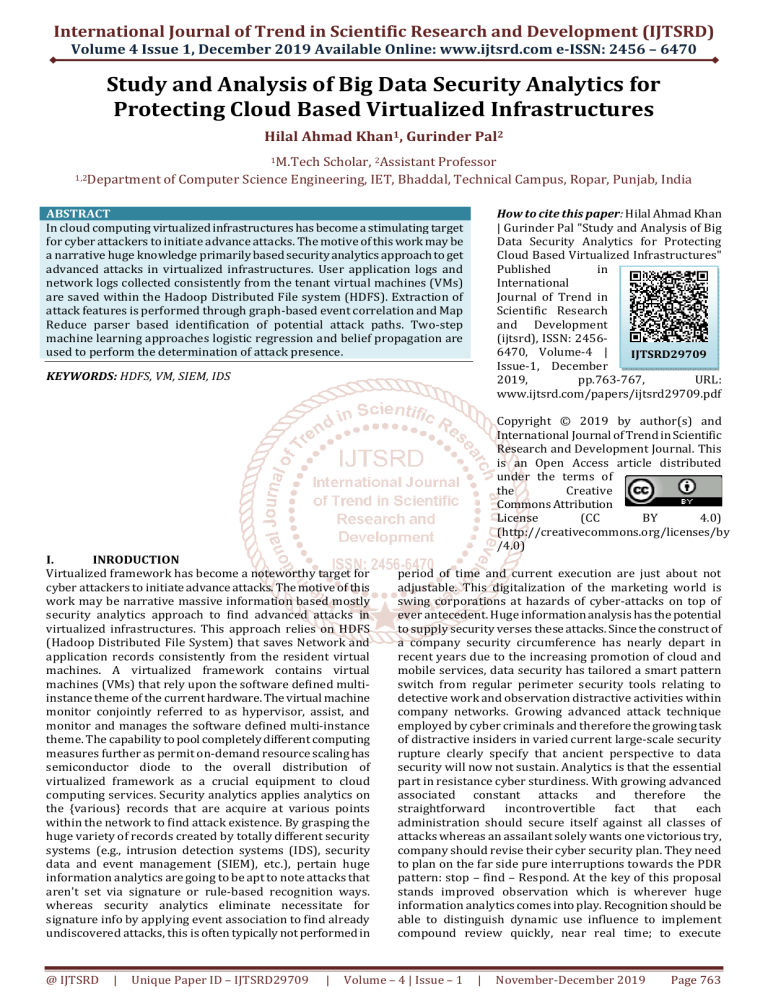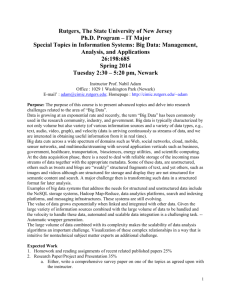
International Journal of Trend in Scientific Research and Development (IJTSRD)
Volume 4 Issue 1, December 2019 Available Online: www.ijtsrd.com e-ISSN: 2456 – 6470
Study and Analysis of Big Data Security Analytics for
Protecting Cloud Based Virtualized Infrastructures
Hilal Ahmad Khan1, Gurinder Pal2
1M.Tech
Scholar, 2Assistant Professor
1,2Department of Computer Science Engineering, IET, Bhaddal, Technical Campus, Ropar, Punjab, India
How to cite this paper: Hilal Ahmad Khan
| Gurinder Pal "Study and Analysis of Big
Data Security Analytics for Protecting
Cloud Based Virtualized Infrastructures"
Published
in
International
Journal of Trend in
Scientific Research
and Development
(ijtsrd), ISSN: 24566470, Volume-4 |
IJTSRD29709
Issue-1, December
2019,
pp.763-767,
URL:
www.ijtsrd.com/papers/ijtsrd29709.pdf
ABSTRACT
In cloud computing virtualized infrastructures has become a stimulating target
for cyber attackers to initiate advance attacks. The motive of this work may be
a narrative huge knowledge primarily based security analytics approach to get
advanced attacks in virtualized infrastructures. User application logs and
network logs collected consistently from the tenant virtual machines (VMs)
are saved within the Hadoop Distributed File system (HDFS). Extraction of
attack features is performed through graph-based event correlation and Map
Reduce parser based identification of potential attack paths. Two-step
machine learning approaches logistic regression and belief propagation are
used to perform the determination of attack presence.
KEYWORDS: HDFS, VM, SIEM, IDS
Copyright © 2019 by author(s) and
International Journal of Trend in Scientific
Research and Development Journal. This
is an Open Access article distributed
under the terms of
the
Creative
Commons Attribution
License
(CC
BY
4.0)
(http://creativecommons.org/licenses/by
/4.0)
I.
INRODUCTION
Virtualized framework has become a noteworthy target for
cyber attackers to initiate advance attacks. The motive of this
work may be narrative massive information based mostly
security analytics approach to find advanced attacks in
virtualized infrastructures. This approach relies on HDFS
(Hadoop Distributed File System) that saves Network and
application records consistently from the resident virtual
machines. A virtualized framework contains virtual
machines (VMs) that rely upon the software defined multiinstance theme of the current hardware. The virtual machine
monitor conjointly referred to as hypervisor, assist, and
monitor and manages the software defined multi-instance
theme. The capability to pool completely different computing
measures further as permit on-demand resource scaling has
semiconductor diode to the overall distribution of
virtualized framework as a crucial equipment to cloud
computing services. Security analytics applies analytics on
the {various} records that are acquire at various points
within the network to find attack existence. By grasping the
huge variety of records created by totally different security
systems (e.g., intrusion detection systems (IDS), security
data and event management (SIEM), etc.), pertain huge
information analytics are going to be apt to note attacks that
aren't set via signature or rule-based recognition ways.
whereas security analytics eliminate necessitate for
signature info by applying event association to find already
undiscovered attacks, this is often typically not performed in
@ IJTSRD
|
Unique Paper ID – IJTSRD29709
|
period of time and current execution are just about not
adjustable. This digitalization of the marketing world is
swing corporations at hazards of cyber-attacks on top of
ever antecedent. Huge information analysis has the potential
to supply security verses these attacks. Since the construct of
a company security circumference has nearly depart in
recent years due to the increasing promotion of cloud and
mobile services, data security has tailored a smart pattern
switch from regular perimeter security tools relating to
detective work and observation distractive activities within
company networks. Growing advanced attack technique
employed by cyber criminals and therefore the growing task
of distractive insiders in varied current large-scale security
rupture clearly specify that ancient perspective to data
security will now not sustain. Analytics is that the essential
part in resistance cyber sturdiness. With growing advanced
associated constant attacks and therefore the
straightforward
incontrovertible
fact
that
each
administration should secure itself against all classes of
attacks whereas an assailant solely wants one victorious try,
company should revise their cyber security plan. They need
to plan on the far side pure interruptions towards the PDR
pattern: stop – find – Respond. At the key of this proposal
stands improved observation which is wherever huge
information analytics comes into play. Recognition should be
able to distinguish dynamic use influence to implement
compound review quickly, near real time; to execute
Volume – 4 | Issue – 1
|
November-December 2019
Page 763
International Journal of Trend in Scientific Research and Development (IJTSRD) @ www.ijtsrd.com eISSN: 2456-6470
complicated correlations over a range of information origin
vary from application logs and server to network events and
user activities. This would like each leading analytics on the
far side straightforward rule-based perspective and
therefore the capability to run analysis on huge quota of gift
and historical information – big data security analytics.
Mingle the current condition of analytics with security helps
administration upgrade their cyber flexibility. Because the
security industry’s feedback to those disputes, a brand new
origination of security analytics solutions has appeared in
current years, that are able to gather, save and examine
monumental amounts of security information over the full
venture in real time. Upgraded by further subject
information and external warning intelligence, this
information is then examining victimization totally different
correlation algorithms to note deviation and thus
acknowledge doable vicious activities. In contrast to classic
SIEM solutions, aforementioned tools utilize in close to real
time and make a tiny low quantity of security attentive align
by intensity consistent with a threat model. These alerts are
improved with further argumentative details and are able to
deeply clarify a security analyst’s job and authorize fast
awareness and reduction of cyber-attacks.
signatures. Security analytics applies analytics on the various
logs which are obtained at different points within the
network to determine attack presence. By leveraging the
huge amounts of logs generated by various security systems
like (intrusion detection systems (IDS), security information
and event management (SIEM), applying big data analytics
will be able to detect attacks which are not discovered
through signature or rule-based detection methods. While
security analytics removes the need for signature database
by using event correlation to detect previously undiscovered
attacks, this is often not carried out in real-time and current
implementations are intrinsically non-scalable. Hence need a
novel big data security analytics approach to protect
virtualized infrastructures against advanced attacks.
II.
PROBLEM DEFINITION
Virtualized infrastructure in cloud computing has become an
attractive target for cyber attackers to launch advanced
attacks. The existing techniques for protecting cloud based
virtualized infrastructure include malware detection and
security analytics. Malware detection usually involves two
steps, first, monitoring hooks are placed at different points
within the virtualized infrastructure then a regularlyupdated attack signature database is used to determine
attack presence. While this allows for a real-time detection of
attacks, the use of a dedicated signature database makes it
vulnerable to zero-day attacks for which it has no attack
III.
METHODOLOGY
The proposed work includes a novel big data based security
analytics (BDSA) approach to protecting virtualized
infrastructures against advanced attacks. With the usage of
network logs and user application logs obtained from the
guest virtual machines stored in HDFS (Hadoop Distributed
File System), our proposed BDSA approach first extracts
attack features through graph-based event correlation, a
Map Reduce parser based identification of potential attack
paths and then ascertains attack presence through two-step
machine learning, namely logistic regression and belief
propagation.
OBJECTIVES
To study and analyze different security techniques.
To propose a novel Big Data Security Analytics approach
for protecting virtualized cloud infrastructures from
advanced cyber-attacks.
To make use of HDFS (Hadoop Distributed File System)
for implementing high end security.
IV.
RESULTS
The results obtained are as under:
Fig.1: Different commands used in work
@ IJTSRD
|
Unique Paper ID – IJTSRD29709
|
Volume – 4 | Issue – 1
|
November-December 2019
Page 764
International Journal of Trend in Scientific Research and Development (IJTSRD) @ www.ijtsrd.com eISSN: 2456-6470
Fig.2: Hadoop make directory
Fig.3: Hadoop file system
Fig.4: Hadoop commands
@ IJTSRD
|
Unique Paper ID – IJTSRD29709
|
Volume – 4 | Issue – 1
|
November-December 2019
Page 765
International Journal of Trend in Scientific Research and Development (IJTSRD) @ www.ijtsrd.com eISSN: 2456-6470
Fig.5: Main menu of demo work
Fig.6: Loading test file with Hive
Fig.7: Performance comparison between Livewire and BDSA
@ IJTSRD
|
Unique Paper ID – IJTSRD29709
|
Volume – 4 | Issue – 1
|
November-December 2019
Page 766
International Journal of Trend in Scientific Research and Development (IJTSRD) @ www.ijtsrd.com eISSN: 2456-6470
V.
CONCLUSION
The research paper presents a novel approach to protect
virtualized infrastructures against advanced attacks. The
BDSA approach first extracts attack features through graphbased event correlation, a MapReduce parser based
identification of potential attack paths and then ascertains
attack presence through two-step machine learning, namely
logistic regression and belief propagation.
[8] Varsha, Amit Wadhwa, Swati Gupta, “Study of Security
Issues in Cloud Computing”, International Journal of
Computer Science and Mobile Computing IJCSMC,
Volume-4, Issue-6, 2015.
REFERENCES
[1] B. Niloufer, S. Jessica Saritha, “Implementation of Big
Data
Protection
Analytics
in
Virtualized
Infrastructures”, International Journal of Technical
Innovation in Modern Engineering & Science (IJTIMES),
Volume-4, Issue-9, 2018.
[10] Monjur Ahmed, Mohammad Ashraf Hossain, “Cloud
Computing and Security Issues In the Cloud”,
International Journal of Network Security & Its
Applications (IJNSA), Volume-6, Issue-1, 2014.
[2] Dr. M. Bhanu Sridhar, A. Koushik, “A Study of Big Data
Analytics in Clouds with a Security Perspective”,
International Journal of Engineering Research &
Technology (IJERT), Volume-6 Issue-1, 2017.
[3] Mr J L Aldo Stalin, M Badhri Narayanan, Mr. M Deepak,
“Security Analytics for Protecting Virtualized
Infrastructures”, Information Systems & eBusiness
Network. 2017.
[4] [4] Thu Yein Win, Huaglory Tianfield, Quentin Mair,
“Big Data Based Security Analytics for Protecting
Virtualized Infrastructures in Cloud Computing”, IEEE,
2017.
[5] Chaowei Yang, Qunying Huang, Zhenlong Li, Kai Liu, Fei
Hu “Big Data and cloud computing: innovation
opportunities and challenges”, International Journal of
Digital Earth, Volume-10, issue-1, 2017
[6] Motukuri Prashanthi, “Analysis of Security Issues in
Virtualization Cloud Computing”, International Journal
of Computer Science and Mobile ComputingIJCSMC,
Volume-5, Issue-8, 2016.
[7] Ali Gholami, Erwin Laure, “BIG DATA SECURITY AND
PRIVACY ISSUES IN THE CLOUD”, International Journal
of Network Security& Its Applications (IJNSA) Volume8, Issue-1, 2016.
@ IJTSRD
|
Unique Paper ID – IJTSRD29709
|
[9] Lidong Wang, Cheryl Ann Alexander, “Big Data in
Distributed Analytics, Cybersecurity, Cyber Warfare
and Digital Forensics”, Science and Education
Publishing, Volume-1, Issue-1, 2015.
[11] Venkata Narasimha Inukollu, Sailaja Arsi, Srinivasa Rao
Ravuri, “Security Issues Associated With Big Data in
Cloud Computing”, International Journal of Network
Security & Its Applications (IJNSA), Volume-6, Issue-3,
2014.
[12] T. Swathi, K.Srikanth, S.Raghunath Reddy,
“Virtualization in Cloud Computing”, International
Journal of Computer Science and Mobile Computing
IJCSMC, Volume-3, Issue-5, 2014.
[13] Muhammad Kazim, Rahat Masood, Muhammad Awais
Shibli, Abdul Ghafoor Abbasi, “Security Aspects of
Virtualization in Cloud Computing”, 2013.
[14] Farzad Sabahi,“Secure Virtualization for Cloud
Environment Using Hypervisor-based Technology”,
International Journal of Machine Learning and
Computing, Volume-2, Issue-1, 2012.
[15] Wentao Liu, “Research on Cloud Computing Security
Problem and Strategy”, IEEE, 2012.
[16] Shubhashis Sengupta, Vikrant Kaulgud, Vibhu Saujanya
Sharma, “Cloud Computing Security - Trends and
Research Directions”, IEEE, 2011.
[17] Pedro Caldeira Neves, Bradley Schmerl, Jorge
Bernardino, Javier Cámara, “Big Data in Cloud
Computing: features and issues”.
Volume – 4 | Issue – 1
|
November-December 2019
Page 767





